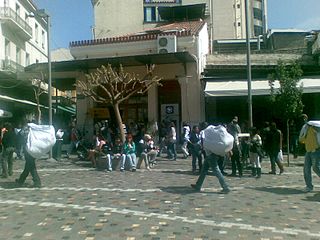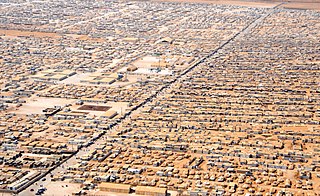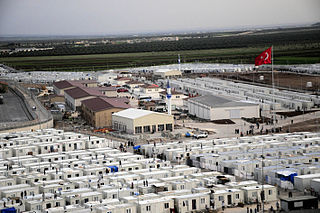The Office of the United Nations High Commissioner for Refugees (UNHCR) is a United Nations agency mandated to aid and protect refugees, forcibly displaced communities, and stateless people, and to assist in their voluntary repatriation, local integration or resettlement to a third country. It is headquartered in Geneva, Switzerland, and has 20,305 staff working in 136 countries as of December 2023.

A refugee, according to the United Nations High Commissioner for Refugees (UNHCR), is a person "forced to flee their own country and seek safety in another country. They are unable to return to their own country because of feared persecution as a result of who they are, what they believe in or say, or because of armed conflict, violence or serious public disorder." Such a person may be called an asylum seeker until granted refugee status by a contracting state or by the UNHCR if they formally make a claim for asylum.
Palestinian refugees are citizens of Mandatory Palestine, and their descendants, who fled or were expelled from their country, village or house over the course of the 1948 Palestine war and during the 1967 Six-Day War. Most Palestinian refugees live in or near 68 Palestinian refugee camps across Jordan, Lebanon, Syria, the West Bank and the Gaza Strip. In 2019 more than 5.6 million Palestinian refugees were registered with the United Nations.

A refugee camp is a temporary settlement built to receive refugees and people in refugee-like situations. Refugee camps usually accommodate displaced people who have fled their home country, but camps are also made for internally displaced people. Usually, refugees seek asylum after they have escaped war in their home countries, but some camps also house environmental and economic migrants. Camps with over a hundred thousand people are common, but as of 2012, the average-sized camp housed around 11,400. They are usually built and run by a government, the United Nations, international organizations, or non-governmental organization. Unofficial refugee camps, such as Idomeni in Greece or the Calais jungle in France, are where refugees are largely left without the support of governments or international organizations.

Afghan refugees are citizens of Afghanistan who were forced to flee from their country as a result the continuous wars that the country has suffered since the Afghan-Soviet war, the Afghan civil war, the Afghanistan war (2001–2021) or either political or religious persecution. The 1978 Saur Revolution, followed by the 1979 Soviet invasion, marked the first major wave of internal displacement and international migration to neighboring Iran and Pakistan; smaller numbers also went to India or to countries of the former Soviet Union. Between 1979 and 1992, more than 20% of Afghanistan's population fled the country as refugees. Following the Soviet withdrawal in 1989, many returned to Afghanistan, however many Afghans were again forced to flee during the civil war in the 90s. Over 6 million Afghan refugees were residing in Iran and Pakistan by 2000. Most refugees returned to Afghanistan following the 2001 United States invasion and overthrow of the Taliban regime. Between 2002 and 2012, 5.7 million refugees returned to Afghanistan, increasing the country's population by 25%.

Immigration to Turkey is the process by which people migrate to Turkey to reside in the country. Many, but not all, become Turkish citizens. After the dissolution of the Ottoman Empire and following Turkish War of Independence, an exodus by the large portion of Turkish (Turkic) and Muslim peoples from the Balkans, Caucasus, Crimea, and Greece took refuge in present-day Turkey and moulded the country's fundamental features. Trends of immigration towards Turkey continue to this day, although the motives are more varied and are usually in line with the patterns of global immigration movements. Turkey's migrant crisis is a following period since the 2010s, characterized by high numbers of people arriving and settling in Turkey.

Throughout the 20th century, Iraq witnessed multiple periods of instability and conflict that prompted the creation and flight of many refugees. Earlier examples include the exodus of Iraqi Jews and the flight of Iraqi Kurds. The Iraqi invasion of Iran in 1980 and the ensuing Iran–Iraq War (1980–1988) triggered a deterioration of ties among the country's various ethnic and religious communities, and also exacerbated in violent events like the Ba'athist Arabization campaigns in northern Iraq (1968–2003), which led to the killing and displacement of thousands of minorities. The Iraqi invasion of Kuwait (1990) and the ensuing Gulf War (1990–1991), which ended with Iraq's defeat and the application of United Nations sanctions (1991–2003), also resulted in the creation of many Iraqi refugees. It was not until the beginning of the ongoing Iraqi conflict, however, that sustained waves of Iraqi refugees would be created, numbering in the millions: the 2003 invasion of Iraq and the ensuing Iraq War (2003–2011) killed and displaced hundreds of thousands of Iraqis, both internally and externally, and the later War in Iraq (2003–2017) forced even more people to flee from the country. Many Iraqi refugees established themselves in urban areas of other countries rather than in refugee camps.

Immigration to Greece percentage of foreign populations in Greece is 7.1% in proportion to the total population of the country. Moreover, between 9 and 11% of the registered Greek labor force of 4.4 million are foreigners. Migrants additionally make up 25% of wage and salary earners.
Since the late 1970s until the present, Iraq has witnessed numerous waves of refugees and emigrants due to significant events in its modern history. These events have led to the displacement of millions of Iraqis. These include over three decades of repression, periodic violent attacks, and massacres targeting the Kurdish population in the north and the Shi'a in the south, all carried out by Saddam Hussein's regime. Other factors include the Iran-Iraq War (1980-1988), the Gulf War of 1991, the prolonged economic sanctions until the overthrow of Saddam Hussein, and the 2003 US-led invasion of Iraq.
Afghan diaspora refers to the Afghan people that reside and work outside of Afghanistan. They include natives and citizens of Afghanistan who have immigrated to other countries. The majority of the diaspora has been formed by Afghan refugees since the start of the Soviet–Afghan War in 1979; the largest numbers temporarily reside in Iran. As stateless refugees or asylum seekers, they are protected by the well-established non-refoulement principle and the U.N. Convention Against Torture. The ones having at least one American parent are further protected by United States laws.
Refugees of the Syrian civil war are citizens and permanent residents of Syria who fled the country in the course of the Syrian civil war. The pre-war population of the Syrian Arab Republic was estimated at 22 million (2017), including permanent residents. Of that number, the United Nations (UN) identified 13.5 million (2016) as displaced persons in need of humanitarian assistance. Since the start of the Syrian civil war in 2011 more than six million (2016) were internally displaced, and around five million (2016) crossed into other countries, seeking asylum or placement in Syrian refugee camps. It is believed to be one of the world's largest refugee crises.

Syrian refugee camp and shelters are temporary settlements built to receive internally displaced people and refugees of the Syrian Civil War. Of the estimated 7 million persons displaced within Syria, only a small minority live in camps or collective shelters. Similarly, of the 8 million refugees, only about 10 percent live in refugee camps, with the vast majority living in both urban and rural areas of neighboring countries. Beside Syrians, they include Iraqis, Palestinians, Kurds, Yazidis, individuals from Somalia, and a minority of those who fled the Yemeni and Sudanese civil wars.
Syrians in Lebanon refers to the Syrian migrant workers and, more recently, to the Syrian refugees who fled to Lebanon during the Syrian Civil War. The relationship between Lebanon and Syria includes Maronite-requested aid during Lebanon's Civil War which led to a 29-year occupation of Lebanon by Syria ending in 2005. Following the outbreak of the Syrian Civil War, refugees began entering Lebanon in 2011.

The 2015 European migrant crisis was a period of significantly increased movement of refugees and migrants into Europe, namely from the Middle East. An estimated 1.3 million people came to the continent to request asylum, the most in a single year since World War II. They were mostly Syrians, but also included a significant number of people from Afghanistan, Pakistan, Iraq, Nigeria, Eritrea, and the Balkans. The increase in asylum seekers has been attributed to factors such as the escalation of various wars in the Middle East and ISIL's territorial and military dominance in the region due to the Arab Winter, as well as Lebanon, Jordan, and Egypt ceasing to accept Syrian asylum seekers.
A refugee crisis can refer to difficulties and dangerous situations in the reception of large groups of forcibly displaced persons. These could be either internally displaced, refugees, asylum seekers or any other huge groups of migrants.

This is a timeline of the European migrant crisis of 2015 and 2016.

Syrians in Turkey, includes Turkish citizens of Syrian origin, Syrian refugees, and other Syrian citizens resident in Turkey. As of December 2024, about 3 million registered refugees of the Syrian Civil War reside in Turkey, which hosts the biggest refugee population in the whole world. In addition, about 75,000 Syrian nationals reside in Turkey with a residence permit. Apart from Syrian refugees under temporary protection and Syrian citizens with a residence permit; 238,768 Syrian nationals acquired Turkish citizenship as of August 2024.

Since the onset of the Syrian Civil War in March 2011, over 1.5 million Syrian refugees have fled to Lebanon, and constitute nearly one-fourth of the Lebanese population today. Lebanon currently holds the largest refugee population per capita in the world.

The Turkish migrant crisis, sometimes referred to as the Turkish refugee crisis, was a period during the 2010s characterised by a high number of people migrating to Turkey. Turkey received the highest number of registered refugees of any country or territory each year from 2014 to 2019, and had the world's largest refugee population according to the United Nations High Commissioner for Refugees (UNHCR). The majority were refugees of the Syrian Civil War, numbering 3.6 million as of June 2020. In 2018, the UNHCR reported that Turkey hosted 63.4% of all "registered Syrian refugees."
The migration and asylum policy of the European Union is within the area of freedom, security and justice, established to develop and harmonise principles and measures used by member countries of the European Union to regulate migration processes and to manage issues concerning asylum and refugee status in the European Union.















